The 5 Ks date from the creation of the Khalsa Panth by Guru Gobind Singh in 1699 at Anandpur Sahib in Panjab.
The Guru introduced them for several reasons:
- Adopting these common symbols would identify members of the Khalsa.
- All members of the Khalsa wear the 5 Ks the members of the community are more strongly bound together.
- Each K has a particular significance.
- The Khalsa will help the helpless and downtrodes.
The meaning of the 5 Ks
The 5 Ks taken together symbolise that the Sikh who wears them has dedicated themselves to a life of devotion and submission to the Guru.
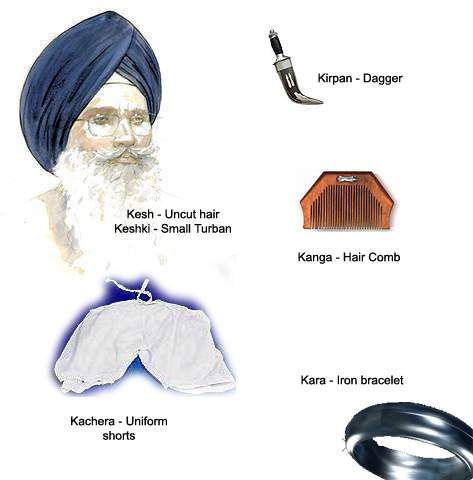
The 5 Ks are 5 physical symbols worn by Sikhs who have taken Amrit and have gone through a special baptism ceremony called "Amrit Shakna".
The five Ks are:
- Kesh (uncut hair)
- Kara (a steel bracelet)
- Kanga (a wooden comb)
- Kaccha - also spelt, Kachh, Kachera (a baggy cotton short)
- Kirpan (sword)
Kesh - uncut hair
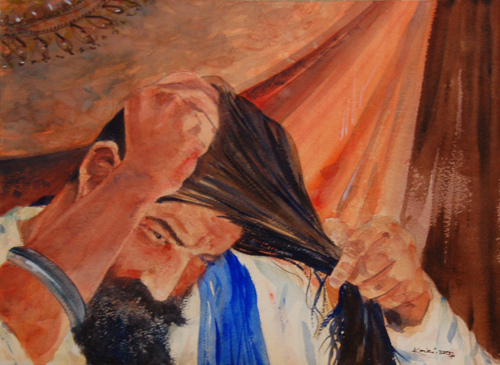
Various reasons and symbolisms have been put forward for the Sikh practice of keeping hair uncut.
- Throughout history hair (kesh) has been regarded as a symbol both of holiness and strength
- One's hair is part of God's creation. Keeping hair uncut indicates that one is willing to accept God's gift as God intended it.
- Uncut hair symbolizes adoption of a simple life, and denial of pride in one's appearance.
- Not cutting one's hair is a symbol of one's wish to move beyond concerns of the body and attain spiritual maturity.
- A Sikh should only bow his head to the Guru, and not to a barber.
- It is a highly visible symbol of membership of the Sikh brotherhood.
- It follows the appearance of Guru Gobind Singh, founder of the Khalsa.
Sikh women are just as forbidden to cut any body hair or even trim their eyebrows, as Sikh men are forbidden to trim their beards.
Kara - a steel bracelet
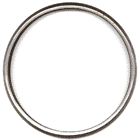
- A symbol of restraint and gentility.
- A symbol that a Sikh is linked to the Guru
- It acts as a reminder that a Sikh should not do anything of which the Guru would not approve.
- A symbol of God having no beginning or end.
- A symbol of permanent bonding to the community-being a link in the chain of Khalsa Sikhs (the word for link is 'kari')
- The Kara is made of steel, rather than gold or silver, because it is not an ornament
Kanga - a wooden comb

This symbolises a clean mind and body; since it keeps the uncut hair neat and tidy.
It symbolises the importance of looking after the body which God has created. This does not conflict with the Sikh's aim to move beyond bodily concerns; since the body is one's vehicle for enlightenment one should care for it appropriately.
Katchera - special underwear
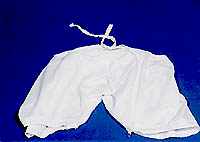
specially made cotton underwear as a reminder of the commitment to purity.
Kachera are short trousers which now are usually worn as undergarments. Guru Gobind Singh told Sikhs to wear short trousers as part of the Khalsa uniform. Some explanations say that this was to distinguish Sikhs from Hindus who traditionally wore dhoti (a long loin cloth). Other explanations offered include the idea that the short trousers made it easier for Sikhs to move in battle. This explanation may be offensive to Sikhs who do not wish to be seen as a violent or aggressive community. For most Sikhs the Kachera is a symbol of modesty and good character.
Kirpan - a ceremonial sword
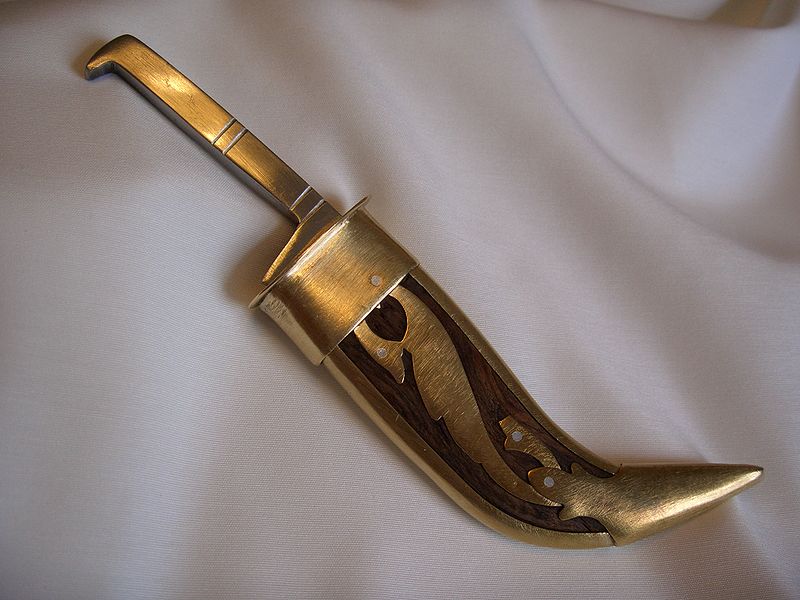
There is no fixed style of Kirpan and it can be anything from a few inches to three feet long. It is kept in a sheath and can be worn over or under clothing.
The Kirpan can symbolise:
- Spirituality
- The soldier part of the Soldier-Saints
- Defence of good
- Defence of the weak
- The struggle against injustice
- A metaphor for God
For a Sikh the fact that the Guru has instructed the Sikhs to wear the 5 Ks is an entirely sufficient reason, and no more need be said.
The symbols have become greatly more powerful with each passing year of Sikh history.
Every Sikh remembers that every Sikh warrior, saint, or martyr since 1699, and every living member of the Khalsa, is united with them in having adopted the same 5 Ks.
Home Page
Copyright 2019 - Guru Nanak Khalsa College. All Rights Reserved.
| 


